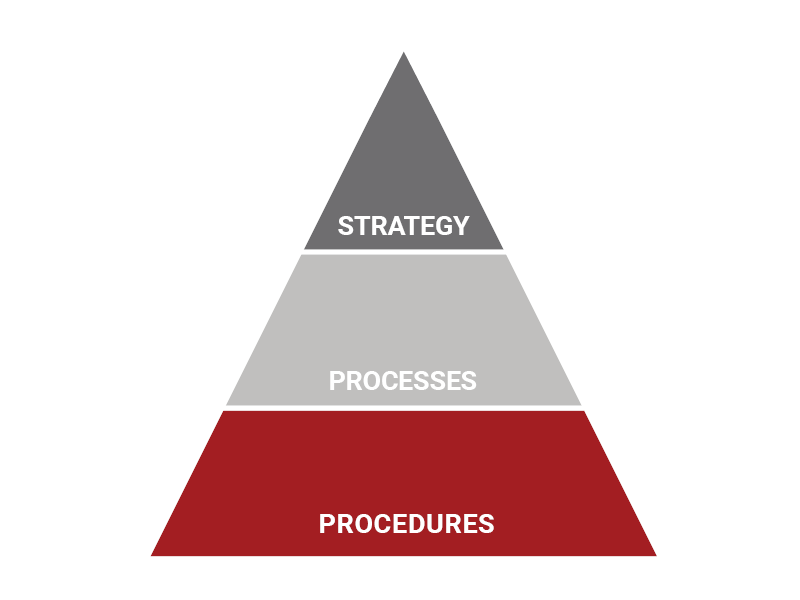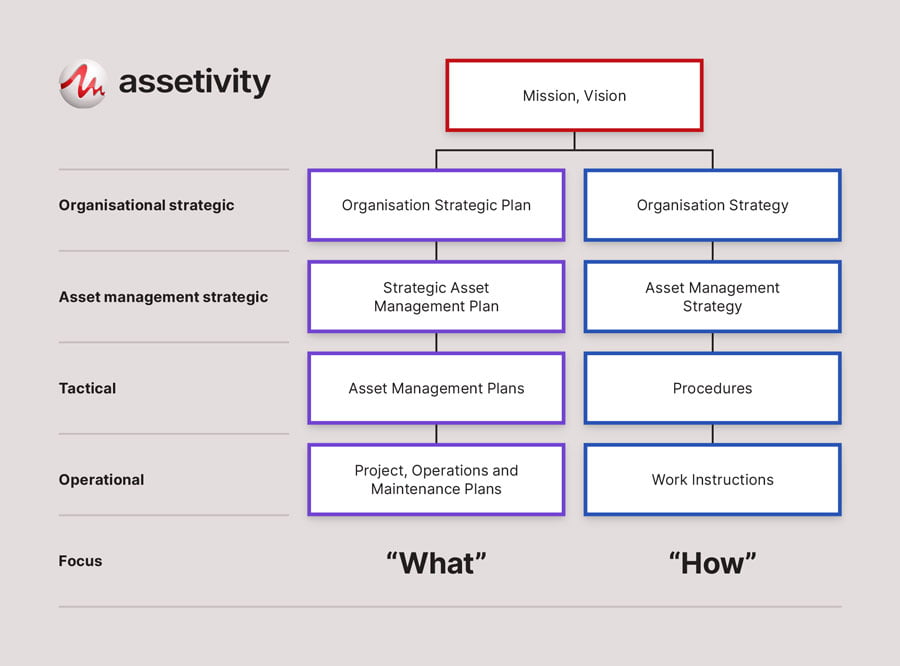In dealings with our clients, we have seen Strategic Asset Management Plans (SAMPs) that are upwards of 200 pages long – mighty tomes that are destined to rapidly become “shelfware” and of little value to anybody.
This article suggests a practical approach that results in a SAMP that is both useful and usable.
ISO 55000 and ISO 55002 state that “A strategic asset management plan can be referred to by other names, e.g. an asset management strategy” (ISO 55000:2014 p8), and “A SAMP can be referred to by other names, e.g. ‘asset management strategy”(ISO 55002:2018 p.6). is this really true? Further, it argues that if you attempt to include both strategy and strategic plan in the same document, then this simply creates a single, bloated document that is unwieldy, difficult to maintain and unlikely to ever be used.
In dealings with our clients, we have seen SAMPs that are upwards of 200 pages long – a mighty tome that is destined to rapidly become “shelfware” and of little value to anybody.
Let’s examine the requirements of ISO 55001 in this area, the guidance provided in ISO 55002, and see if we can arrive at an approach that will result in a SAMP that is both useful and usable.
ISO 55001 requirements and ISO 55002 guidance
ISO 55001 specifies the need for a Strategic Asset Management Plan (SAMP) to exist, and ISO 55000 defines this document as:
Documented information that specifies how organisational objectives are to be converted into asset management objectives, the approach for developing asset management plans, and the role of the asset management system in supporting achievement of the asset management objectives (ISO 55000:2014, p.14)
ISO55001 includes several requirements that relate to the SAMP. These include requirements for the SAMP to:
- Document the asset management objectives
- Document the role of the asset management system in supporting achievement of the asset management objectives
In addition, the SAMP must:
- Embrace the scope of the asset management system (as defined by the organisation)
- Provide direction for the organisation’s asset management system
- Be aligned with other related documents, including the asset management policy and asset management plans
This gives us a broad flavour of the document but provides very little guidance regarding the contents expected of this document, despite its clearly pivotal role in the asset management document hierarchy.
Perhaps recognising this gap, the updated version of ISO 55002, published in 2018, included an Annex which provided extensive guidance in this area. However, we must recognise that ISO 55002 is a guidance document only – the only mandatory requirements are those included in ISO 55001.
ISO 55002:2018, in Annex C, states that the fundamental purpose of the SAMP is to:
- Translate organisational objective into strategic AM objectives,
- Document the role of the assets, AM and the AM system in supporting achievement of the organizational objectives,
- Guide the approach for developing AMPs and the AM system, applying the AM policy,
- Document the decision-making criteria to realise value,
- Present a consolidated plan at the portfolio level for achieving the strategic AM objectives, and
- Present a plan for creating and improving the AM system
It then goes on to list 18 individual content elements that it recommends be considered for inclusion in the SAMP. This includes elements such as:
- an overview of the organization’s context, i.e. external and internal issues, stakeholder needs and requirements and a summary of the organisational plan
- how the assets contribute to the organisation’s activities
- how the asset management system enables coordination, control, performance measurement, review and continual improvement
- a high-level overview of the composition of the asset portfolio
- strategic asset management objectives (e.g. at portfolio-level) and how these are cascaded down to lower levels
- the approach for implementing the asset management policy
- Asset management decision-making criteria
- the scope of the asset management system
- the approach for achieving the strategic asset management objectives
- the asset portfolio-level plan, and the associated financial plan, to achieve the strategic asset management objectives
- plans for creating or improving the asset management system to achieve the asset management objectives
- the approach for monitoring progress in implementing the SAMP
These are only a few of the many elements that ISO 55002 recommends be included in the SAMP, and it is clear that if all of this information is to be included in this one document, then it is, indeed, likely to be a 200 page document for a larger organisation. And experience tells us that 200-page documents tend not to be read, and are extremely difficult to maintain.
So we really need a more practical solution. And one way we can do this is by first considering the difference between a strategy and a plan.
Strategy vs. plan
What is a plan?
In our training workshops, when we ask participants what they would expect to see in a plan, they almost without exception state that they would expect a plan to contain actions with their associated:
- Timeframes
- Responsibilities, and
- Resource requirements (money, people etc.)
This is not an unreasonable expectation. In short, a plan tells you what needs to be done, by when, by whom, and what resources you need. It does not tell you how to perform these actions.
Furthermore, if this is the expectation from a plan, then clearly the plan needs to be updated on a frequent basis in line with the timeframes used to monitor progress against the plan. If timeframes change (as they inevitably do), or resource requirements change – or even if the actions to be performed change, then the plan needs to be updated.
What is a strategy?
Ann Latham, as outlined in her Forbes article “What The Heck Is A Strategy Anyway?” states that “The biggest problem with the way organizations think about strategy is they confuse strategy with plans.” Her definition of a strategy is that it is “a framework for making decisions….”. In other words, it outlines how things are to be done, as distinct from a plan which describes what is to be done. A strategy is not the same thing as a strategic plan.
Of course, by definition, the strategy will be higher-level, bigger picture and longer-term in nature. As one of a suite of documents, a strategy presents the big-picture view of how things are done and how decisions are to be made. Processes and procedures will provide progressively more detail at lower levels. One way of visualising this is through the following diagram.

So why the confusion regarding Strategic Asset Management Plans?
If we accept the concepts outlined above, we should expect the Strategic Asset Management Plan to be both strategic and a plan. That is, it should be:
- High level – it relates to the big picture and focuses on the most important (and possibly most expensive) activities to be performed for the organisation to achieve its asset management objectives
- Longer-term – it takes a longer-term view of the activities required for asset management success.
- Action-oriented – it describes the activities to be performed in order to meet asset management objectives, and their associated timeframes, responsibilities and resource requirements. Being a “plan”, it should describe what is to be done, but not how it is to be done.
In short, we would expect the SAMP to exist as a high-level, longer term action plan focusing on the most important actions to be taken for the organisation to ensure that it achieves its asset management objectives.
However, the definition of the Strategic Asset Management Plan contained within ISO 55001 states that it is “documented information that specifies how organizational objectives are to be converted into asset management objectives, the approach for developing asset management plans, and the role of the asset management system in supporting achievement of the asset management objectives” (ISO 55000:2014 p.14 – emphasis added).
Nothing in this definition suggests that the SAMP should be action-oriented; that it should contain the actions required to ensure that asset management objectives are achieved. Quite the contrary, it explicitly states that this document is required to specify how things are to be done. Furthermore, this is reinforced by statements in ISO 55000 that state that “The principles by which the organization intends applying asset management to achieve its organizational objectives should be set out in an asset management policy. The approach to implementing these principles should be documented in a strategic asset management plan (SAMP)” (ISO 55000:2014 p8).
ISO 55002 further reinforces this view by stating that “The SAMP details the asset management objectives, explains their relationship to the organizational objectives and the framework required to achieve the asset management objectives” (ISO 55002:2018 p.6).
This, to our (and most people’s) way of thinking is not the definition of a plan. It is, however, a pretty good definition of an asset management strategy. The confused thinking in ISO 55001 relating to the difference between a Strategy and a Strategic Plan is only highlighted by the notes in both ISO 55000 and ISO 55002 which state that “A strategic asset management plan can be referred to by other names, e.g. an asset management strategy” (ISO 55000:2014 p8), and “A SAMP can be referred to by other names, e.g. ‘asset management strategy’”(ISO 55002:2018 p.6). No wonder there is confusion amongst those trying to interpret ISO 55001.
We think it essential that you consider who will use the SAMP and/or asset management strategy and what they will use them for. Further, you should carefully consider the size of each document, and the amount of effort involved in updating them.
We find it helpful to visualise the difference between strategies and plans using the following diagram.

Our recommendations
In preparing the SAMP, it is our recommendation that the document is split in two – one containing the “how” elements (which probably won’t change often) and the other containing the “what” elements. This will assist in ensuring that the SAMP is useful and valuable and reduces the risk of it becoming “shelfware” – a document that is filed, but rarely used or referred to.
To illustrate the importance of the difference between these two documents, consider, for example, an organisation that has decided to outsource some of its maintenance activities (e.g. light vehicle maintenance). This is a “how” question and, if it is strategically important, should be described in the asset management strategy. However, if there are existing contracts that are in place for this activity, and that, through these contracts, the organisation is achieving its asset management objectives, then there need not be an equivalent action in the Strategic Asset Management Plan. These contracts would continue to be managed through existing processes and procedures.
However, if the organisation was transitioning from in-house maintenance to outsourced maintenance, and it was strategically important that this is done well, this would likely result in a Strategic Initiative to be included within the SAMP. Or if the contract needed to be renegotiated because it was not delivering the desired results, then this could also results in a different Strategic Initiative being included in the SAMP.
In future articles, we will discuss what a good asset management strategy should look like and what a good Strategic Asset Management Plan (SAMP) should contain.
How can Assetivity help?
We have helped many organisations to align and certify their asset management systems and associated documentation with the requirements of ISO 55001:2014. Our practical approach helps clients move beyond compliance and allows them to deliver greater business value through more effective and efficient asset management.
If you would like help to create better, more useful Strategic Asset Management Plans, contact us now.
